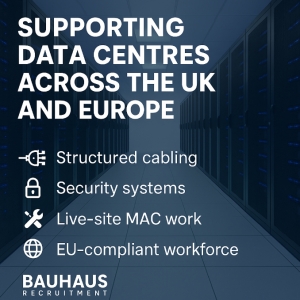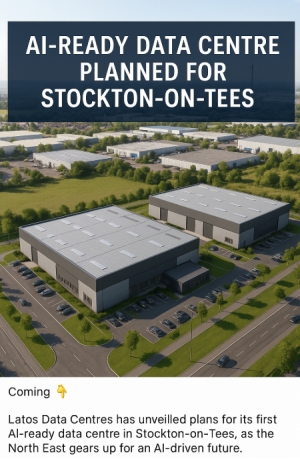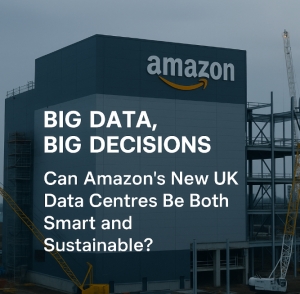Test Owner
At Bauhaus Recruitment, data cabling sits at the centre of our expertise. We have delivered experienced engineers to data centres across the UK and Europe, supporting everything from new-build construction to live migrations, patching, containment works and full white space fit-outs.
Our teams are trusted by some of the industry’s leading contractors and end-users. Whether it’s a hyperscale development in the Midlands or a secure site migration in mainland Europe, we provide compliant, qualified, and project-ready engineers who understand the critical nature of data centre environments.
Our Data Centre Capabilities Include:
Structured Cabling Installations
We supply engineers to install, terminate, test, and label Cat5e, Cat6, Cat6a and fibre optic networks. Every installation is carried out to client standards, using Fluke or OTDR testing as required.
New Build and High-Level Containment Works
Our operatives regularly support basket, ladder rack, galvanised trunking, and cable tray installs on new-builds and refurbishments. IPAF, PASMA and ECS cards are standard across our high-level teams.
Racking, Stacking and Patch Panel Work
We support cabinet builds, racking and stacking, patching to client schedules, cable dressing, and full cabinet documentation. Our teams work cleanly and efficiently in both new and live environments.
Security Systems
We supply engineers experienced in access control, CCTV, door entry, intruder alarms, and intercoms. From first fix to commissioning, we support full security fit-outs across data centres and critical environments.
Hot Aisle Containment and Cooling Infrastructure
We’ve installed containment systems for hot aisle, cold aisle and in-row cooling systems, ensuring clients can meet thermal performance and airflow targets.
Migrations and Relocations
From physical hardware relocations to structured cabling changes during data centre moves, we provide specialist teams with the care, coordination and site awareness needed for complex migrations.
Live-Site Additions and Change Works
Our engineers are trusted to work in live data halls, carrying out moves, additions and changes without disruption. All work is documented, labelled and signed off in line with client protocols.
24/7 Coverage and Reactive Support
We offer round-the-clock cover for clients who require overnight installs, weekend change windows or emergency response. Whether it’s planned or reactive, we can mobilise engineers quickly and reliably.
European Deployments and Compliance
Bauhaus supports projects across Ireland, Germany, the Netherlands and wider Europe. We handle A1 certificates, EU payroll solutions, and compliant resourcing using EU-passport engineers.
Why Bauhaus?
- Extensive database of UK and EU-based engineers
- Deep experience in structured cabling, containment, security systems and commissioning
- Trusted by tier 1 contractors and data centre operators across the UK and Europe
- Strong understanding of EU compliance, live-site protocols and health & safety
- Flexible resource models including permanent, contract and 24/7 reactive support
From initial containment to final patching, Bauhaus Recruitment continues to support the data centre industry with the people and precision it demands. If you're planning a project and need reliable, qualified engineers, we’re ready to deliver.
Get in touch today to discuss how we can support your data centre project.
The growth of renewable energy is reshaping many industries, and data cabling is right at the centre of it. As wind, solar and hydro projects continue to expand across the UK and beyond, driven by government backing and corporate sustainability goals, the need for reliable infrastructure has never been greater. This is creating new opportunities for data cabling professionals whose expertise is essential to keeping everything connected.
With regulatory bodies like Ofgem supporting the transition, renewable energy projects are becoming increasingly technical and widespread. These developments rely on complex data networks to manage operations, monitor performance and ensure long-term efficiency. As a result, the skill set for data cabling engineers is evolving. It is no longer just about traditional wiring. Engineers now need to understand software integration, network security and how to protect critical data.
In terms of employment, the renewable energy sector is becoming a major source of jobs in the UK. Roles vary from installing cabling systems at new renewable facilities to upgrading and maintaining existing infrastructure to support smart grid technologies. These positions require strong technical knowledge along with adaptability and problem-solving skills, as the pace of innovation in renewable energy remains fast-moving.
At the same time, the shift towards greener energy is influencing other areas such as data centres, which are under pressure to improve their sustainability. This is adding further demand for experienced data cabling professionals who can help deliver low-energy, eco-efficient solutions.
Looking ahead, the future for data cabling specialists in the renewable energy space looks very promising. With technology advancing and the push for sustainability growing stronger, these roles are becoming increasingly important. For those working in construction or infrastructure, keeping pace with these changes and developing skills in renewable-related cabling is key to tapping into the opportunities this fast-growing sector offers.
The recent announcement by Pinewood Group about their ambitious plan for a £1bn data centre near their iconic film studios in Buckinghamshire not only underscores a significant pivot towards digital infrastructure but also spotlights the burgeoning synergies between technology and sustainable development. This new venture represents a strategic expansion into the digital realm, signifying a broad scope of opportunities for construction and technical professionals. With a massive 55,000m² facility in the works, alongside environmentally conscious additions like a 60-acre nature reserve and a substantial community garden, this project is uniquely poised to set benchmarks in both technology and community integration.
The strategically chosen location within the Slough Availability Zone highlights the critical nature of regional planning in enhancing the UK's data capacity. This decision, paired with the designation of data centres as Critical National Infrastructure by the government, emphasizes the integral role such facilities play not only in data management but also in national security and economic development. This insight is particularly vital for industry professionals focused on infrastructure and data centre construction, underscoring the necessity for cutting-edge skills in data cabling and systems management.
David Conway, CEO of Pinewood Group, has articulated the multifaceted benefits of the development, promising significant job creation and a boost to the local economy through "the delivery of a nature reserve, community gardens, and learning space." These elements introduce a compelling dialogue about the role of corporate responsibility in modern developments and the potential for projects to deliver beyond commercial benefits. For recruitment agencies specializing in construction and technical placements, this is a clarion call to prepare a workforce that is adept not only in high-tech installations but also in environmental stewardship and community engagement.
The multi-layered implications of this proposed development extend well into the foreseeable future. With planning approval anticipated by the end of 2025, there remains ample time for the workforce to align with the emerging demands of this field. Recruitment strategies must evolve promptly to address the need for skilled professionals capable of navigating the complex intersections of digital technology and sustainable construction practices. For those in construction recruitment, now is the time to harness this momentum, promoting skill development and strategic hiring that will meet the escalating needs of the UK's infrastructure and data centre boom.
In conclusion, the Pinewood Group's data centre project is not just an investment in digital storage and processing capabilities; it is a blueprint for the future of construction and technological integration. The planned facility in Buckinghamshire represents a significant step towards blending industrial expansion with environmental and social gains, setting a high standard for future projects in the UK and possibly globally. As this project progresses, it will undoubtedly provide a wealth of opportunities for professional growth and development within the construction and technology sectors.
The North East is Powering Up: Two Major Data Centre Projects Signal a Digital Revolution
The North East is rapidly emerging as one of the UK’s most strategically important tech regions. With Latos Data Centres unveiling plans for a new high-tech data centre in Stockton-on-Tees, and Blackstone’s £10 billion hyperscale development already underway in Northumberland, the area is on the cusp of a major AI-led transformation.
Stockton’s AI-Ready Data Hub
Latos has submitted proposals to build its first facility at Preston Farm Industrial Estate. This new site would feature two data halls and office space, offering infrastructure specifically designed to meet rising demand from AI and advanced digital workloads.
The project is expected to generate around 150 local jobs during its construction and operational phases, boosting the Teesside economy and positioning Stockton as a hub for next-generation digital infrastructure.
Meanwhile, in Northumberland
Just up the road in Cambois (near Blyth), Blackstone-backed QTS is progressing with one of the largest data centre campuses in Europe.
Key facts:
- Estimated cost: £10 billion
- Ten large-scale data halls
- Around 1,200 construction jobs and 400 permanent roles
- £110 million pledged to local infrastructure, training, and community investment
This project has full backing from Northumberland County Council and major pension fund investment, including the UK’s USS (Universities Superannuation Scheme).
A Growing Demand for Talent
These projects are separate, but they overlap in one major area: workforce.
Together, they will create sustained demand for:
- Data cabling and structured cabling engineers
- Electrical and mechanical contractors
- IT infrastructure and support technicians
- Project managers and technical operations specialists
There is a genuine risk of labour shortages if recruitment, training, and talent pipelines don’t keep up. This will impact contractors, recruiters, and the wider supply chain across the North East. For companies already operating in the data centre space, competition for qualified personnel could become intense.
Conclusion: Infrastructure is Only Half the Challenge
The developments in Stockton and Northumberland represent a massive vote of confidence in the region’s digital future. But infrastructure alone isn’t enough. Delivering these projects successfully will depend on having the people in place — and that means upskilling, training, and mobilising the North East’s tech workforce at pace.
The next few years could define the region’s place in the UK’s AI and digital landscape. These two projects are just the beginning.
A major data centre project backed by Amazon is taking shape near Houghton Regis in Bedfordshire. It is already one of the most talked-about infrastructure developments in the UK.
Jobs and Investment on a Massive Scale
Known as Linmere Island, the complex will sit on a 22-acre greenfield site and is set to become a key part of the UK’s digital backbone. Amazon Web Services (AWS) plans to invest £8 billion in UK data centres, a move the Government has hailed as a signal that "Britain is open for business."
The project is expected to create hundreds of construction jobs and support long-term technical and operations roles once the site is active. In the surrounding region, this could deliver a real boost to the local economy, from logistics and facilities to skilled IT and infrastructure work.
The Power Challenge and the Opportunity
Data centres require significant power to operate. This site alone is projected to use 114.8 million kWh annually, equivalent to powering more than 42,000 homes. However, this also presents a unique opportunity to position the UK as a leader in green, low-carbon data infrastructure.
Here are a few possibilities:
Green Energy Commitments
Although early plans include just 140 solar panels, there is scope to go further:
- On-site solar or wind generation could help offset demand
- Battery storage solutions could reduce strain on the grid
- Partnerships with UK renewable suppliers may ensure a more sustainable energy mix
Smarter Cooling Solutions
Water usage is another important consideration, but several efficient alternatives exist:
- Closed-loop cooling systems can minimise water waste
- Heat recovery systems could supply local homes or buildings
- Smart HVAC controls allow energy-efficient, on-demand cooling
Cleaner Backup Options
The current plan includes 42 diesel generators to ensure resilience. Long term, there are cleaner alternatives:
- Hydrogen fuel cells
- Biofuel-powered generators
- Grid-tied battery systems
A Model for Sustainable AI Infrastructure
Data centres have been designated critical national infrastructure. They are vital to AI development, healthcare systems, financial platforms and cloud computing. The challenge is how to support digital growth while maintaining net zero commitments.
With thoughtful planning and green innovation, Linmere Island could become a flagship for sustainable digital infrastructure in the UK and beyond.
In Summary
The energy demands are significant, and environmental concerns are valid. But this project also creates an opportunity to lead by example, generating skilled jobs, driving economic recovery and embracing smart green technologies.
We should not just build more data centres.
We should build better, cleaner, future-ready infrastructure for the UK.
Big news for South Manchester. Planning permission has now been granted for a brand-new £32 million Culture Hub in Wythenshawe town centre. This marks the first phase of a wider £500 million redevelopment of the Civic district.
This isn’t just a facelift. It’s a complete reimagining of what the town centre can become.
What’s Coming
The new Culture Hub will rise on the site of the former Co-op store and feature:
Ground floor: Vibrant food and drink outlets to encourage footfall and social connection
First floor: Flexible spaces for creative studios, workshops, exhibitions, and community events
Second floor: A 200-seat theatre complete with rehearsal space, designed to showcase local talent and host live performances
Who’s Delivering It
Construction is scheduled to begin in autumn 2025, with opening expected in spring 2027. The development is a collaboration between Manchester City Council and a private development partner, with a major UK contractor expected to deliver the build.
Funding the Vision
£20 million of funding is coming from central government through Levelling Up initiatives. Manchester City Council is contributing a further £11.9 million. This £32 million investment is part of a much larger £500 million regeneration plan for Civic.
Why It Matters
The Culture Hub is more than just a building. It represents a commitment to transforming the local high street and supporting the long-term future of Wythenshawe. It will act as a cultural anchor for the area, supporting:
Up to 2,000 new homes
A new public park
Modern workspaces and retail units
Improved infrastructure and access to public transport
This development puts community, creativity, and connection at the heart of regeneration.
In Summary
Project Name: Wythenshawe Culture Hub
Total Budget: £32 million (first phase)
Construction Start: Autumn 2025
Expected Opening: Spring 2027
Main Features: Food outlets, studios, theatre
Wider Development: Part of a £500 million Civic regeneration plan
Net Zero or National Growth?
Net Zero vs. National Growth: What QTS’s £10bn Data Centre Tells Us About the UK’s AI Infrastructure Challenge
In the race to become a global leader in AI and digital infrastructure, the UK government faces a clear trade-off: scale up fast or stay green. The new £10bn “hyperscale” data centre project near Blyth, Northumberland, led by QTS and backed by Blackstone, is the latest lightning rod in this national balancing act.
What’s Happening in Blyth?
QTS plans to build 10 large-scale data centres across a 133-acre site, with construction starting later this year. Once operational, the site is expected to emit more CO₂ annually than Birmingham Airport — roughly 184,000 tonnes. For context, that’s about 12% of Northumberland’s entire industrial emissions target by 2030.
Powering AI, But at What Cost?
Data centres, especially those underpinning AI workloads, consume vast energy. Estimates suggest global AI-related centres may demand 23GW of power by the end of 2025. The UK’s total current demand is around 30GW.
This strain on the grid explains why nuclear is back on the table. Microsoft and Google are investing in nuclear solutions to support AI expansion, but even they’ve admitted to rising emissions in recent reports.
The Net Zero Dilemma
Keir Starmer’s administration, like many before it, champions tech investment to fuel growth. But can the UK meet its 2050 net zero commitments if each new site rivals an airport in emissions?
Despite calls for more renewables or battery storage, QTS has deemed such options "impractical" for now. They’ve promised energy-efficient design and water-cooled infrastructure, but questions remain.
What This Means for Our Industry
For those of us involved in structured cabling, infrastructure recruitment, and mission-critical builds, this development underlines two truths:
- Data centre growth is not slowing. If anything, AI demand is accelerating hyperscale builds faster than regulations can adapt.
- Sustainability will be a growing pressure point. Clients, councils, and communities will increasingly scrutinise emissions and energy usage on projects.
Final Thoughts
This isn’t just a planning story — it’s a signal. Whether you’re recruiting cleared engineers, designing DC fitouts, or advising on fibre deployment, the sustainability conversation is becoming central. Expect councils to ask tougher questions and clients to lean more on suppliers who understand both the technology and the environmental nuance.
The UK wants to be an AI powerhouse. But the cables, cooling and kilowatts behind that vision must walk a tightrope between growth and green.
We regularly supply engineers with active security clearance into the data cabling and technical infrastructure sectors. Whether it’s SC Cleared engineers for live MOD sites, Enhanced DBS for schools, or Baseline Clearance for new-build MOJ prisons, we’ve got people who are vetted, experienced, and ready to go.
We understand the requirements around clearance levels. Some projects like live prisons or defence work need full SC clearance. Others, such as new-builds or school installations, may only require Enhanced DBS or Baseline clearance. We’ve placed engineers on MOD and MOJ sites, government buildings, and education projects, so we know exactly what’s involved.
The nature of these sites means there’s only so much we can say publicly, but what we can say is that we know how to get the right people in place for secure and sensitive work. Our engineers are used to working in controlled environments where professionalism, discretion and reliability are essential.
If you’re a client looking for SC Cleared data cabling engineers, or you need staff with Baseline or Enhanced DBS clearance, feel free to get in touch.
And if you're a fibre or data cabling engineer who already holds clearance, we’d be happy to speak with you about upcoming opportunities.
At Bauhaus, we are specialists in providing data cabling and structured cabling solutions to contractors and principal suppliers delivering major retail projects across the UK.
We understand that in today's retail environment, connectivity is crucial — powering everything from EPOS systems and tills to digital signage, Wi-Fi networks, and inventory management systems.
Our experienced teams have supported projects for some of the UK's most recognised retail brands, including H&M, Chanel, ASDA, Tesco, and M&S.
Our structured cabling and data cabling services have played a vital role in store openings, refurbishments, and national rollout programmes.
Our Retail Cabling Services
We support all aspects of retail technology infrastructure, including:
- Data cabling installation for new stores, refurbishments, and upgrades
- Structured cabling solutions to support EPOS systems, tills, and Wi-Fi
- High-level cabling works for ceiling-mounted access points and devices
- Ad hoc cabling support for night works and urgent projects
- Long-term cabling support for national rollout programmes
Our teams are highly experienced in delivering works in live retail environments, often completing projects overnight or outside of trading hours to minimise disruption.
Why Choose Bauhaus for Your Data Cabling Projects?
- Fully Qualified Engineers: All staff hold IPAF certification, Asbestos Awareness, and full health and safety training.
- Flexible Deployment: From short-notice cabling callouts to fully managed, long-term structured cabling rollouts.
- Proven Retail Expertise: Supporting contractors on projects for leading retail brands.
- Commitment to Quality: We ensure that every data cabling project meets the highest standards for reliability and performance.
Planning a Retail Cabling Project?
If you are delivering a retail fit-out, refurbishment, or nationwide rollout and need expert support for data cabling or structured cabling, Bauhaus is ready to help.
Contact us today to discuss how our specialist cabling teams can add value to your next retail project.
When news broke that Universal Studios plans to build its first European theme park in Bedfordshire, the headlines rightly focused on tourism, job creation, and economic growth. But behind the magic of blockbuster rides and immersive experiences lies something less glamorous yet absolutely vital: data cabling infrastructure.
The Real Infrastructure Behind the Attractions
While rollercoasters steal the limelight, none of it functions without the right network. From ticketing systems and ride control networks to on-site Wi-Fi, security, and smart crowd flow management, robust data cabling is the hidden powerhouse that will help bring this £50 billion economic boost to life.
A development of this scale needs more than just fibre—it needs future-proofed network cabling that can support:
- Real-time ride monitoring and safety systems
- Contactless payments and mobile app integration
- High-definition CCTV and facial recognition for security
- IoT-based maintenance systems for predictive servicing
- Guest Wi-Fi and connectivity across hundreds of acres
It’s no exaggeration to say that CAT6A, CAT7, and fibre optic cables are as crucial to this resort as concrete and steel.
Smart Resorts Need Smart Infrastructure
Universal has already set the tone for smart entertainment in its parks around the world. Bedfordshire will be no exception. Expect advanced queue management systems, AR/VR integration, and smart hotel room controls—all reliant on seamless data transmission.
This brings data cabling to the forefront of not only the construction phase but ongoing operations. As the park evolves, so too must its infrastructure. Designing for flexibility—trunking routes, server room capacity, and zoned cabling—will ensure the site is ready for tech upgrades long after opening day in 2031.
Opportunities for the UK Data Cabling Sector
The Bedford resort isn't just a win for entertainment—it's a massive opportunity for UK data cabling specialists. With 8,000 permanent roles anticipated and tens of thousands of workers during the build, the demand for high-quality M&E contractors and network cabling engineers will spike.
This project could lead to:
- Large-scale commercial cabling contracts
- Specialist work in fibre optics and AV integration
- Upskilling of local engineers and apprentices
- Supply chain boosts across the electrical and comms sectors
If done right, Universal Bedford could become a showcase of UK engineering excellence—from the rides to the rack cabinets.
A Call for Standards and Excellence
With high visitor numbers and safety-critical systems, there's no room for shortcuts. Universal will likely demand:
- Adherence to BS EN 50173 and ISO/IEC 11801 standards
- Thorough cable testing and certification
- Use of LSZH (Low Smoke Zero Halogen) sheathing for safety
- Detailed as-built documentation and labelling
This is a chance for British firms to step up and deliver to the gold standard.
Conclusion: A Foundation Built on Connectivity
Universal Studios Bedford promises to be a landmark development for the UK. But behind the visitor experience lies a complex technical ecosystem—one that depends on high-quality, future-ready data cabling.
For contractors and suppliers in this space, the project offers not just commercial potential, but a chance to contribute to a major national infrastructure build.












